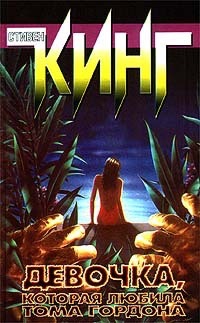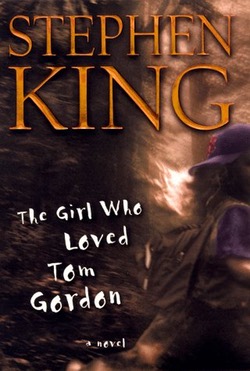Publishers have learned to be indulgent when their bestselling authors get bitten by the sports bug. In 2004, John Grisham published Bleachers and three years later he released his football novel, Playing for Pizza. In 1993, Tom Clancy became part-owner of the Baltimore Orioles. And in 1999, Stephen King suddenly decided that he wanted to publish a slim (for King) 244-page book called The Girl Who Loved Tom Gordon.
At the time, Gordon was a pitcher for the Boston Red Sox, and his new publisher, Scribner, probably decided that this was just a sports itch their new acquisition needed to scratch. “If books were babies, I’d call The Girl Who Loved Tom Gordon the result of an unplanned pregnancy,” King said in a letter to the press, and Scribner decided to roll with it, eager to release anything from their new star, who definitely had some blockbusters in the pipeline once he got this Tom Gordon nonsense off his chest. Expecting something forgettable, instead they wound up publishing a small miracle.
The idea for The Girl Who Loved Tom Gordon came to King during a Red Sox game when he was in a lull between finishing Bag of Bones and starting Hearts in Atlantis. King has often used the period between books to write a novella (which is how most of the stories in Different Seasons came about) but he’d never written a completely new book during one of these breaks before. But, as he says, “Stories want only one thing: to be born. If that’s inconvenient, too bad.”
 If King ever wrote a YA novel, it would be The Girl Who Loved Tom Gordon. When her divorced mom takes her and her brother on a hike up the Appalachian Trail, Trisha McFarland ducks off the path to pee and gets lost. Nine years old and scared of the dark, Trisha winds up stumbling through the woods for nine days, wandering farther and farther from civilization as she tries to make her way back home, striking out confidently in exactly the wrong direction again and again. As she walks, dehydration, hunger, and exhaustion cause her to hallucinate, and she begins to believe that she’s being stalked by a supernatural beast known as The God of the Lost. Her one contact with civilization is listening to Red Sox games on her Walkman as pitcher Tom Gordon, her personal hero, sets a record with 43 consecutive saves in the 1998 season. As Trisha becomes more and more beat down by nature and The God of the Lost, Gordon appears to her in a vision to offer guidance and counsel (King got Gordon’s approval to use him in the book before he started writing). At the end of the book, Trisha confronts the God of the Lost, who turns out to be a black bear, defeats him, and finds her way home. It’s a small story, but King tells it from Trisha’s point of view, and inside her feverish brain it’s a metaphysical epic.
If King ever wrote a YA novel, it would be The Girl Who Loved Tom Gordon. When her divorced mom takes her and her brother on a hike up the Appalachian Trail, Trisha McFarland ducks off the path to pee and gets lost. Nine years old and scared of the dark, Trisha winds up stumbling through the woods for nine days, wandering farther and farther from civilization as she tries to make her way back home, striking out confidently in exactly the wrong direction again and again. As she walks, dehydration, hunger, and exhaustion cause her to hallucinate, and she begins to believe that she’s being stalked by a supernatural beast known as The God of the Lost. Her one contact with civilization is listening to Red Sox games on her Walkman as pitcher Tom Gordon, her personal hero, sets a record with 43 consecutive saves in the 1998 season. As Trisha becomes more and more beat down by nature and The God of the Lost, Gordon appears to her in a vision to offer guidance and counsel (King got Gordon’s approval to use him in the book before he started writing). At the end of the book, Trisha confronts the God of the Lost, who turns out to be a black bear, defeats him, and finds her way home. It’s a small story, but King tells it from Trisha’s point of view, and inside her feverish brain it’s a metaphysical epic.
 King, like Nathaniel Hawthorne and centuries of American writers before him, finds a flinty spirituality in the wilderness, and what makes Tom Gordon such a spectacular coming of age novel is that it addresses faith, something that’s all too often left out of young adult books due to nervous editors who don’t want to offend readers. The fact is, at some point in their teens, most kids grapple with the idea of God with an intensity that would put many adults to shame. King portrays the wrestling that Trisha does without an ounce of condescension, dealing with her spiritual struggle honestly. In this endless forest, Trisha, who doesn’t really believe in God, comes to believe that something bigger is going on around her. Guided by Tom Gordon, who ritualistically points to the sky after every save, Trisha’s interior life and exterior life merge in a series of hallucinations that lead her to believe in her own version of God. According to her, “What is God? The one who comes in at the bottom of the ninth.”
King, like Nathaniel Hawthorne and centuries of American writers before him, finds a flinty spirituality in the wilderness, and what makes Tom Gordon such a spectacular coming of age novel is that it addresses faith, something that’s all too often left out of young adult books due to nervous editors who don’t want to offend readers. The fact is, at some point in their teens, most kids grapple with the idea of God with an intensity that would put many adults to shame. King portrays the wrestling that Trisha does without an ounce of condescension, dealing with her spiritual struggle honestly. In this endless forest, Trisha, who doesn’t really believe in God, comes to believe that something bigger is going on around her. Guided by Tom Gordon, who ritualistically points to the sky after every save, Trisha’s interior life and exterior life merge in a series of hallucinations that lead her to believe in her own version of God. According to her, “What is God? The one who comes in at the bottom of the ninth.”
King gets away with so much that editors wouldn’t allow these days. The story of one girl lost in the woods for nine days fits in neatly with his novels like Misery (two people trapped in a house) and Gerald’s Game (one woman trapped on a bed), but today an editor would probably insist that Tom Gordon is “too small” and require some kind of high concept twist. I can easily imagine an editor insisting that The God of the Lost and Trisha battle throughout the book, whereas King lets the challenges that face Trisha mostly be mundane — hunger, thirst, hard walking, cliffs. She’s stalked by the God of the Lost throughout but only confronts him 17 pages from the end.
 King is also allowed a degree of ambiguity that I think a lot of writers would have a hard time getting since, in my experience, editors usually require things to be spelled out clearly for readers. An editor would probably insist that the God of the Lost either be a supernatural phantom, or a bear, but it would have to be one or the other. Instead, King gives us an ambiguous creature that could be just a bear, but is also somehow larger than that. King walks a middle ground between reality and dreams here, investing his book with a symbolic weight, rooting it both in the reality of wilderness survival and in the reality of spirituality. The result is a book that is smaller in concept than what I think would be acceptable today, but is ultimately so much bigger in spirit.
King is also allowed a degree of ambiguity that I think a lot of writers would have a hard time getting since, in my experience, editors usually require things to be spelled out clearly for readers. An editor would probably insist that the God of the Lost either be a supernatural phantom, or a bear, but it would have to be one or the other. Instead, King gives us an ambiguous creature that could be just a bear, but is also somehow larger than that. King walks a middle ground between reality and dreams here, investing his book with a symbolic weight, rooting it both in the reality of wilderness survival and in the reality of spirituality. The result is a book that is smaller in concept than what I think would be acceptable today, but is ultimately so much bigger in spirit.
King’s second-shortest book, The Girl Who Loved Tom Gordon, hit shelves on April 6, opening day of the Red Sox 1999 season. It’s a still, small marvel of a book, one of King’s most spiritual and most moving, accomplishing a lot of what The Green Mile set out to do only with less plot machinery and visible effort. It was launched with the standard 1.25 million copies in its first printing, and landed at #2 on the New York Times bestseller list, then rose to #1 where it remained for 18 weeks. While it was on the list, King went out walking in the woods himself one day, only instead of encountering the God of the Lost he was hit by a van and nearly died. He wouldn’t write for five weeks, and by the time he returned he was off the wagon and addicted to painkillers. It would be a long time before his writing got this good again.
Grady Hendrix has written for publications ranging from Playboy to World Literature Today and his latest novel is Horrorstör, about a haunted Ikea.










